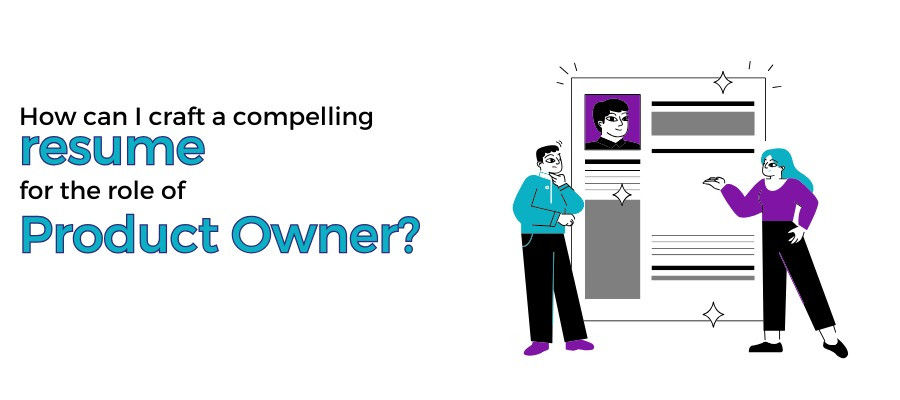How can I craft a compelling resume for the role of Product Owner?

If you're into information technology and like setting goals and leading teams in projects, you might think about becoming a Product Owner. Companies that use Agile methods appreciate skilled Product Owners who can lead Scrum projects in different aspects like strategy, design, and marketing.
To improve your odds of getting a Product Owner job, creating a resume clearly showing your understanding, experience, and abilities in managing Scrum and Agile projects is important. This article gives you some tips and tricks to write an effective Product Owner resume.
Tips for Crafting a Compelling Product Owner Resume
- Contact Information:
Place your contact details at the top of your resume. Keep it simple and organized, including your name, city, state, phone number, professional email address, and a link to your online portfolio, if applicable.
- Professional Summary:
Craft a tailored professional summary for each job application. In a few lines, describe yourself, highlighting your experience, key skills, and noteworthy achievements. Customize this section to capture the hiring manager's attention.
- Work Experience:
List your relevant work experience, starting with the most recent. Include roles related to Agile teams, even if they aren't specifically Product Owner positions. For each role, mention your title, company name, employment dates, and primary responsibilities. Describing your duties helps demonstrate your suitability for the role.
- Skills Showcase:
Highlight your hard and soft skills in this section. Match your skills to the job description's requirements. For a Product Owner role, emphasize soft skills like communication, leadership, organization, and technical skills such as Agile project management, Scrum framework, or software development tools.
- Education Details:
Provide your most recent Education history. Include higher degrees and omit high school if you have a bachelor's degree or beyond. Specify the degree's name, the university attended, and dates of attendance. Highlight any academic awards or notable extracurricular achievements.
- Certifications:
Include relevant certifications, especially Agile or IT project management certifications. Tailor this section to the job's requirements. List the certification title, issuing organization, and the date of certification. Certifications showcase specialized knowledge and training.
- Review and Edit:
Before submitting your resume, carefully review and edit it. Ensure it's error-free and presents a professional image. This attention to detail reflects positively on you and contributes to a polished document.
What is ATS? What Does It Have to Do With Resume?
ATS (Applicant Tracking System) is a system organizations use to filter out the best candidates for their company. If your resume doesn't meet ATS requirements, it's often rejected before it reaches human eyes.
Companies utilize this system to save hiring managers time and effort sorting through numerous applications. However, this can prevent your resume from reaching the people you want to see it.
To make your resume ATS compliant as a Product Owner, you must tailor it to meet ATS criteria. You have a great chance of getting seen by identifying the most important keywords and adding them to your resume.
It's a smart idea to address the job requirements. If the position demands specific skills or experiences, such as project management, include them in your resume. Don't save this information for a cover letter; ensure it's in your resume to be processed by the system.
Key Sections for Your Product Owner Resume
Once you've sorted out your format and keywords, let's focus on the essential sections to include in your resume. We'll also touch on what you might want to omit.
Product Owner Professional Header: After passing through the ATS screening, your professional header becomes crucial in maintaining the hiring manager's interest. It's typically the first thing they see when your resume lands on their desk. Your header should include:
- Full name
- Job title (Product Owner)
- Phone number
- LinkedIn profile link
- Portfolio link (if applicable)
- City of residence
- Email address
Avoid feeling pressured to include your complete address for safety reasons. Focus on your job title, ensuring it aligns with your target job. Consistency here shows your fit for the position and shouldn't be overlooked.
Summary or Objective: Briefly overview your experience, skills, and aspirations. This section can help set the tone for the rest of your resume and provide a snapshot of your suitability for the role.
Skills: List the key skills that make you an excellent Product Owner. Include technical skills, Agile methodologies, project management tools, and other relevant proficiencies.
Professional Experience: Detail your work history, highlighting your accomplishments and responsibilities as a Product Owner. Focus on quantifiable achievements that demonstrate your impact.
Education: Provide information about your Educational background, including degrees, institutions, and relevant certifications.
Additional Sections (if applicable): Depending on your experience, you might include sections like "Certifications," "Projects," or "Publications."
Conclusion
While you can include more information, remember that the real treasure lies in the details. Capture hiring managers' attention with strong job titles and pertinent work experiences. Retain their interest by demonstrating how your skills align with the job description.
Feeling overwhelmed is natural, but remember that editing can lead to perfection. Your initial resume draft might not be your final submission. Begin by writing freely and letting your thoughts flow. Then, use this guide to refine your resume step by step. It's a process that can significantly improve your resume.
Reference
- https://www.jobscan.co/blog/8-things-you-need-to-know-about-applicant-tracking-systems/
- https://sg.indeed.com/career-advice/resumes-cover-letters/product-owner-resume




